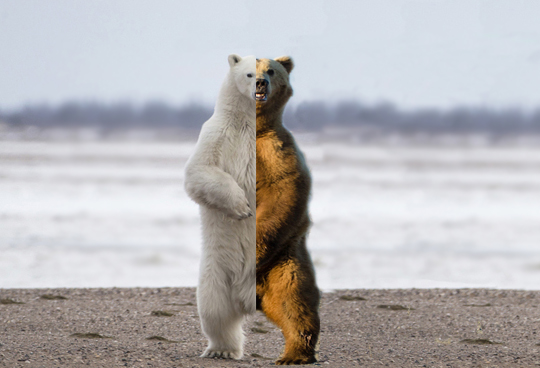
Climate change is blamed for many things these days, but one of the weirder consequences of a warming Earth is an increased number of incidents when grizzlies get jiggy with polar bears. Yep. If you go down to the woods today you really won’t believe your eyes.
Officially, the result of such mixed-species mating shenanigans is either called a ‘pizzly’ if the father is a polar bear, or a ‘grolar bear’ if the dad is a grizzly, and proof of the existence of such hybrid animals was provided this month, when a local hunter killed one in Arviat, on the west shore of Hudson Bay in Nunavut, deep in the Canadian Arctic.
Didji Ishalook thought the bear he’d shot was a little odd. ‘It looks like a polar bear but…it’s got brown paws and big claws like a grizzly, and the shape of a grizzly head,’ the 25-year-old told CBC News.

Bear specialists believe his victim was a hybrid between a grizzly and a polar bear, and they say that such animals are becoming increasingly common. The two species are genetically similar, and according to several experts, as the polar regions shrink and temperatures rise, their traditional stomping and romping grounds are becoming less distinct
Although cross species copulation and conception had previously occurred in captivity, the first wild ‘grolar bear’ was discovered in 2006, when National Geographic reported an American called Jim Martell shooting one dead in Canada’s Northwest Territories.
The finding—verified by DNA tests that revealed the animal’s father was a grizzly and its mother was a polar bear—absolutely astonished experts at the time, not least because both species go through extended mating rituals before producing off-spring, which suggests this wasn’t the result of a fleeting encounter.
It’s still extremely rare for hybrid bears to be seen in the wild, and full tests are yet to be done on the latest possible contender, but Dave Garshelis, research scientist from the Minnesota Department of Natural Resources and a world-renowned bear expert, believes the body belongs to a grizzly-polar bear hybrid, and not an albino grizzly bear.
‘An albino bear would have a light-coloured or pink-coloured nose, and no pigmentation in the eyes and the claws,’ Garshelis told CBC. ‘This bear has a black nose, and normal dark-coloured eyes and claws. So, it’s not an albino.’
Garshelis went on to explain why such animals could become more common. ‘With climate change, grizzly bears are moving further north, so there is more overlap between grizzly bears and polar bears in terms of their range,’ he said. ‘There are even American black bears that are moving further north. And a few black bears have been spotted outside of Arviat.’
We’ve even got an Animalogic episode examining what happens when grizzlies and polar bears get it on, but fascinating though this all is, it’s not a good sign. As long ago as 2010, an editorial in the journal Nature cautioned that such hybridisation ‘can be the final straw in loss of species’.
‘It is not a good thing for the future of polar bears that we see this hybridization occurring,’ Chris Servheen, a bear biologist at the University of Montana, told Vice News this month. ‘It’s not going to result in some kind of new bear that is successfully living in the Arctic.’
It does, however, prove that bears are nothing if not opportunists when it comes to mating as well as munching. Elsewhere in Canada, another species of bear has been busy demonstrating how smart they can be when hungry, with black bears invading towns in Alberta (which are largely deserted after the recent massive fires) and going on the rampage through people’s abandoned larders, fridges and freezers.
